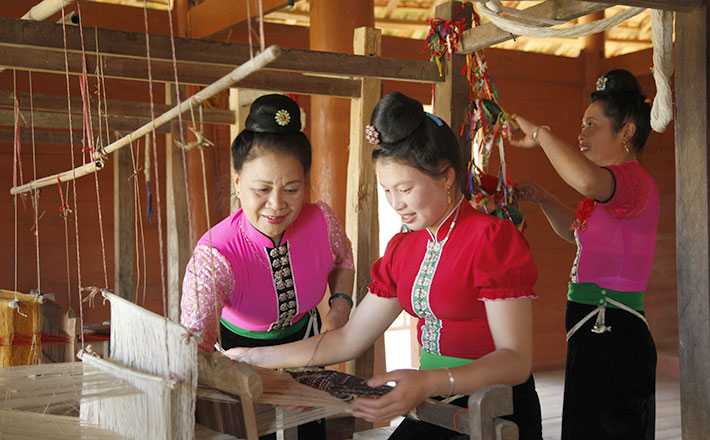
Tang Cau: A Sacred Symbol of Fidelity of Black Thai Women
- on Jun 25, 2025 By: Phuong Mai NGUYEN
Visitors to the Northwest of Vietnam will surely be impressed by the sight of Black Thai women with their neat, upward-coiled hair buns. This distinctive look is a hallmark of the Tằng Cẩu ritual—a traditional custom deeply rooted in the cultural identity of the Black Thai people.
This article invites you to explore the fascinating aspects of this tradition, from its origins and profound meanings to its execution and continued presence in modern life.
Overview of Tang Cau
Tằng Cẩu, or the up-do hairstyle ritual, is a unique and sacred ceremony in the lives of Black Thai women, a subgroup of the Thai community scattered in the Northwest region of Vietnam. This is a distinctive custom marking a significant turning point in a Thai girl's life when she gets married. Tang Cau is not merely a hairstyle; it is a clear indicator that a woman is married, distinguishing her from unmarried girls.
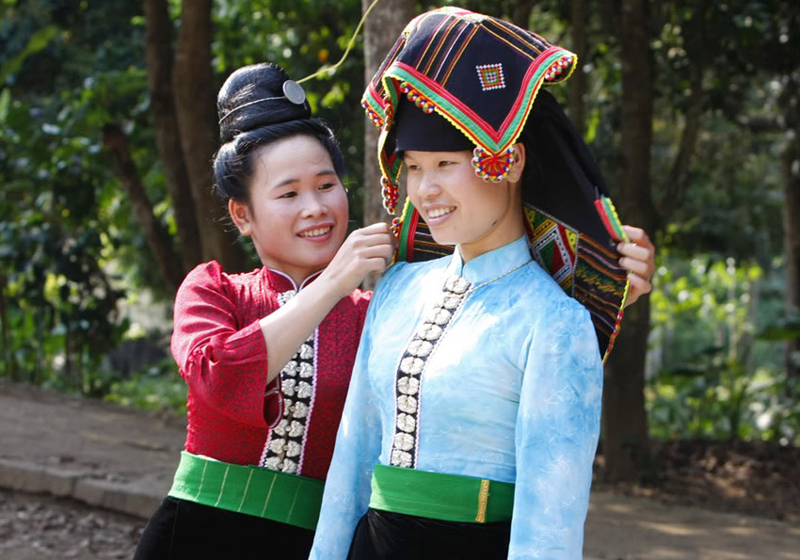
Unveiling the Secrets Behind a Unique Hairstyle
An Ancient Legend behind the Tang Cau Custom
The Tang Cau custom is intertwined with a poignant legend of the Black Thai people. Long ago, a husband and wife lived happily with their children. However, one day, the wife fell in love with another man and abandoned her family. The enraged husband sharpened a bamboo stick and set out to find his wife. One afternoon, as he passed by a stream, he saw his wife and her lover. In a fit of fury, the husband lunged the sharpened bamboo stick towards them, killing both. When their souls ascended to the heavens, the sky god "Phỏ Phạ" imprisoned both sinful souls in a dark dungeon. Later, Then Na – the deity who granted sinful souls rebirth on earth on behalf of "Phỏ Phạ" – allowed the wife to be reborn. However, she had to bear a sharp object on her head forever as a reminder to remain faithful throughout her life. If she ever strayed, that sharp object would pierce her head, just like her husband's bamboo stick in her previous life. Therefore, in the Tàng Cẩu custom of the Thái people, the hairpin symbolizes that sharp object, and the hair bun represents the woman's head in the legend, serving as a perpetual reminder for married women to remain faithful.
Tang Cau: More Than Just a Hairstyle, It's a Vow of Fidelity
To wear the Tang Cau hairstyle, a Black Thai woman must undergo a ritual of the same name (the ritual also has a different name called Khứn Cẩu) that holds profound and significant meanings in her life, as the fundamental purpose of this ritual and hairstyle is to distinguish married Black Thai women from unmarried ones.

This ritual also affirms the unwavering fidelity and loyalty of a woman to her husband and her respect for her in-laws' family. Furthermore, it is a promise to safeguard and protect her husband, children, and their home. It is considered a guiding principle, a moral way of life that protects the marriage and family.
How the Tang Cau Ritual takes place
The Tang Cau ritual takes place at the bride's home, usually in the room where she sleeps, before the groom's side arrives to escort the bride to his home. To prepare for this ritual, on the morning of the wedding day, the bride's friends help her wash her hair at a nearby stream. The Thai people believe that the stream's water washes away the old, allowing the bride to embark on her new life clean and light.
From the groom's side, a delegation is sent to the bride's home. This group includes young, beautiful maidens and strong, resourceful married women who are well-versed in customs and skilled in styling the bride's hair into an up-do. The matchmaker chosen must be virtuous, healthy, have many children and grandchildren, and be particularly knowledgeable about the Tang Cau styling techniques. The bride's family also prepares a corresponding number of people, including two bridesmaids, usually close friends of the bride.
The Tang Cau ceremonial tray, meticulously prepared by the bride's parents, includes: a plate with four cups of wine and a bottle of wine; a winnowing basket holding two bowls of rice, on top of which are 2 eggs and 2 flowers; a roll of white fabric, a roll of red fabric; a hair pin, a hair bun cover; a set of áo cóm (traditional Thai top) and skirt, a belt; two silver bracelets, a purse chain, a mirror, a comb; a pair of false hair buns; and a bowl of goosegrass water. In addition, there must be a comb for styling the bride's hair and a bowl of fresh water containing three pebbles taken from three different river bends, along with a bundle of goosegrass harvested from three different gardens. The three pebbles symbolize three generations living together in good health, a firm belief in building a happy home, and resilience against decay. The three bundles of goosegrass represent unity, prosperous business, abundant blessings, and a peaceful, happy life.
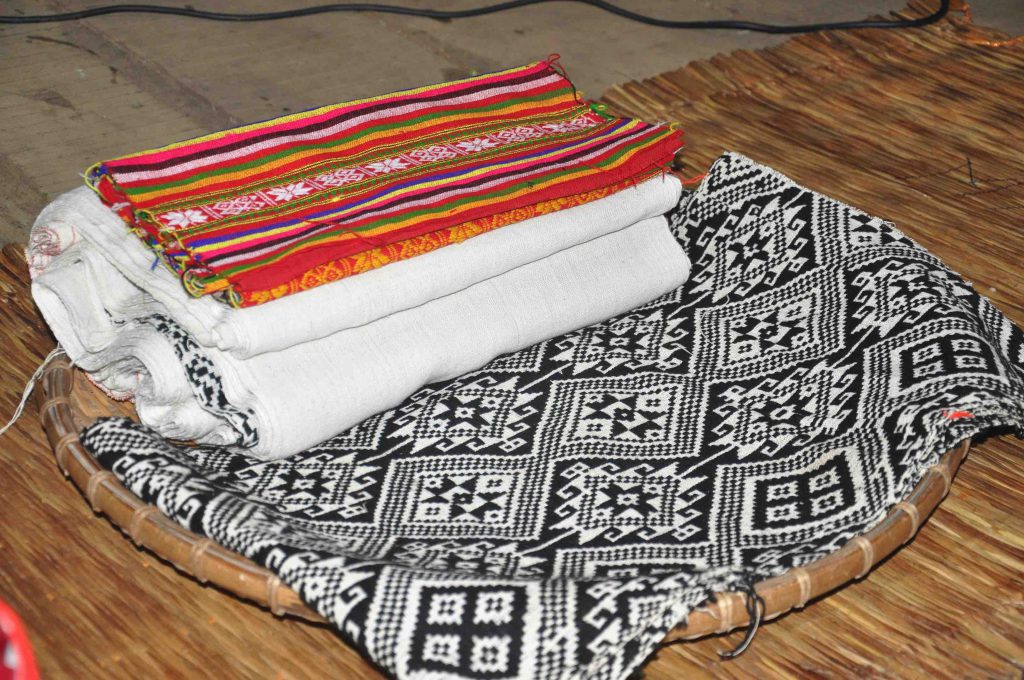
Once the ceremonial tray is ready, the ritual begins. The bride, dressed in beautiful traditional attire, is led by her mother to sit on a mat in front of the ceremonial tray, facing east. Relatives from both sides of the family place gifts (either physical items or money) on the tray, accompanied by heartfelt wishes for the young couple.
The bride's mother or aunt will then let down her daughter's hair for the groom's family to proceed with the up-do styling. The person chosen to perform the Tang Cau (known as "Nai Cẩu") – usually the bride's mother, aunt, or a knowledgeable matchmaker from the groom's family—stands behind the bride. The "Nai Cẩu" dips a comb into the goosegrass water and gently combs the hair from the nape of the neck upwards towards the front, coiling it along with a false hair bun onto the crown of the head.
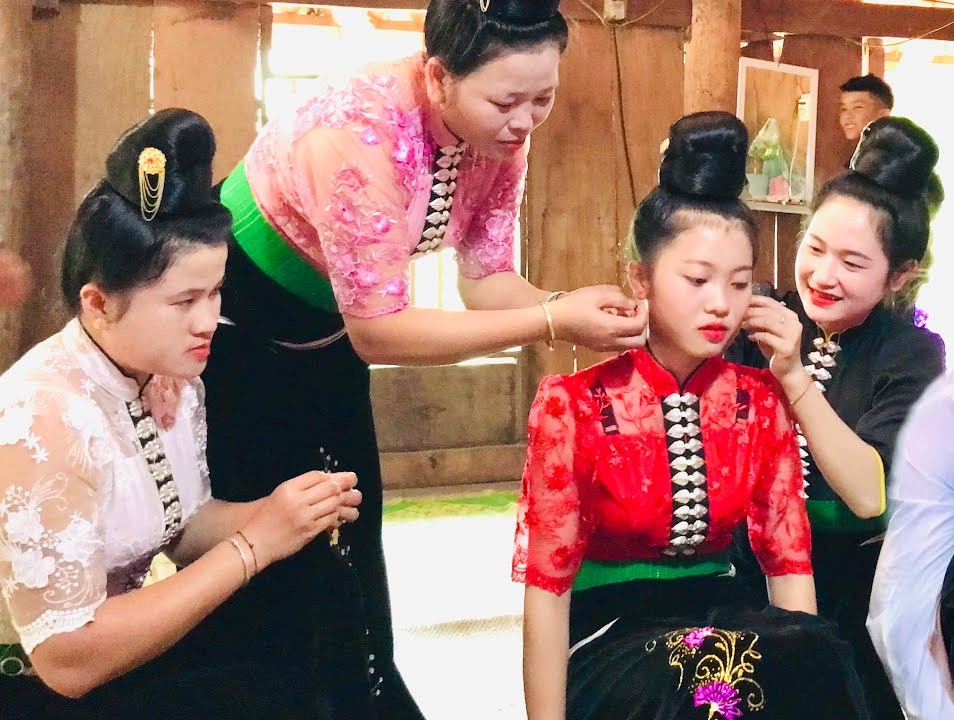
While styling the hair, the practitioner simultaneously recites words of advice and blessings. These blessings often include phrases like: "Long hair, comb it smoothly / Coil it up into "Tàng Cẩu" / From now on, you are a married woman / Water does not change its course / Your heart does not change its direction, my child." These words admonish the bride that, from this day forward, as a married woman, she must remain eternally faithful to her husband.
After the hair is completely styled, the "Nai Cẩu" gently inserts a silver pin through the hair bun to secure it and make the beautiful silver pin stand out against the lustrous black hair of the new bride. Simultaneously, the matchmaker will sing loving words of advice and blessings for the couple's happiness once the Tang Cau ritual concludes.
Upon completion of the Tang Cau ceremony, that hairstyle is never let down. Only upon her husband's death is she allowed to unbind her hair and style it as a widow's bun. Should she wish to unbind her Tang Cau after the mourning period, she must also perform a similar ceremony, witnessed by both families.
Tang Cau in Modern Life
The hairstyle remains an integral part of life for Black Thai women, whether they are managing household chores or participating in traditional festivals. This hairstyle not only enhances their physical beauty but also embodies the essence of the Thai woman's soul.

Contemporary life has ushered in many changes and cultural assimilations, yet the Tang Cau custom among Thai women has adeptly adapted to modern living conditions and working environments. While not all women who marry today choose to perform the Tang Cau ritual and to wear this hairstyle, those who do maintain this tradition continue to express a unique beauty and preserve a distinct cultural heritage that distinguishes them from other ethnic groups in Vietnam.
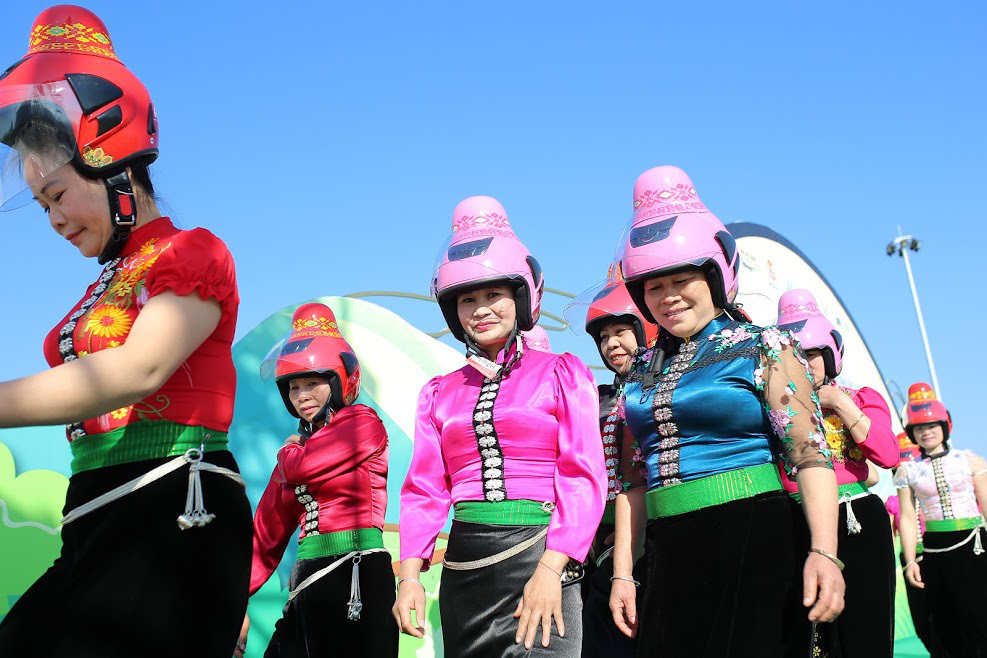
In recent years, to preserve and promote the cultural value of the Tang Cau ritual of the Black Thai people, the Ministry of Culture, Sports, and Tourism has researched, restored, preserved, and widely promoted and performed this ritual to the general public and tourists. These activities hold great significance in showcasing the beautiful cultural aspects of the Black Thai ethnic group and have garnered significant interest and positive feedback from both domestic and international audiences. Although time and life may change, the Black Thai people always strive to preserve their age-old customs, and the Tang Cau custom is the clearest testament to this, beautifully and distinctly embodying the soul and character of Black Thai women throughout their lives.
Related articles:
>> Ghost-expelling Ritual: A Sacred Tradition of the Phu La People
>> Visit the Y Ty Market in Lao Cai and Meet the Black Ha Nhi People
 Español
Español Français
Français







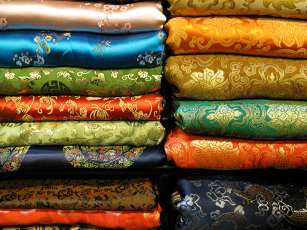
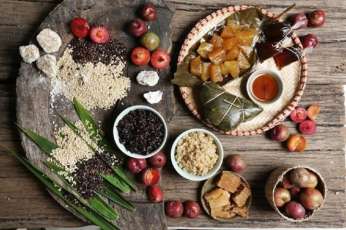

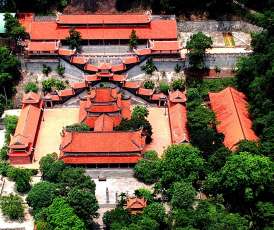









TraZefUK
on Nov 28, 2025HerbertPhomaMS
on Oct 19, 2025Lilyan Cuttler
on Oct 15, 2025Avenue17XC
on Sep 14, 2025Avenue18JL
on Jul 21, 2025